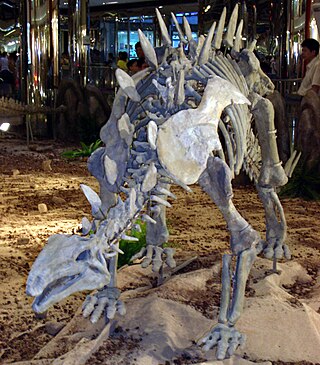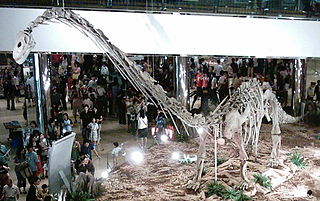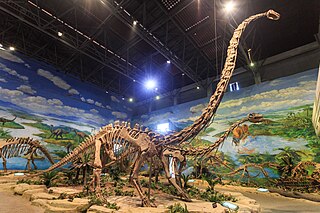
Mamenchisaurus is a genus of sauropod dinosaur known for their remarkably long necks which made up nearly half the total body length. Numerous species have been assigned to the genus; however, many of these might be questionable. Fossils have been found in the Sichuan Basin and Yunnan Province in China. Several species are from the Upper Shaximiao Formation whose geologic age is uncertain. However, evidence suggests that this be no earlier than the Oxfordian stage of the Late Jurassic. M. sinocanadorum dates to the Oxfordian stage and M. anyuensis to the Aptian stage of the Early Cretaceous around 114.4 mya. Most species were medium to large size sauropods, around 15 to 26 meters in length and possibly up to 35 meters (115 ft) based on two undescribed vertebrae.

Diplodocids, or members of the family Diplodocidae, are a group of sauropod dinosaurs. The family includes some of the longest creatures ever to walk the Earth, including Diplodocus and Supersaurus, some of which may have reached lengths of up to 42 metres (138 ft).

Yangchuanosaurus is an extinct genus of metriacanthosaurid theropod dinosaur that lived in China from the Middle Jurassic to Early Cretaceous periods, and was similar in size and appearance to its North American and European relative, Allosaurus. Yangchuanosaurus hails from the Upper Shaximiao Formation and Suining Formation and was the largest predator in a landscape that included the sauropods Mamenchisaurus and Omeisaurus and the stegosaurs Chialingosaurus, Tuojiangosaurus and Chungkingosaurus. This theropod was named after the area in which was discovered, Yongchuan, in China.

Abrosaurus is a genus of macronarian sauropod dinosaur from the Middle Jurassic Period of what is now Asia, one of many dinosaurs found at the Dashanpu Quarry in the Sichuan Province of China. Like most sauropods, Abrosaurus was a quadrupedal herbivore but it was rather small for a sauropod, not much more than 30 feet (9.1 m) long. Its head was boxy and topped with a tall bony arch containing the nostrils.

Shunosaurus, meaning "shu lizard", is a genus of sauropod dinosaur from Late Jurassic (Oxfordian) beds in Sichuan Province in China, from 161 to 157 Million years ago. The name derives from "Shu", an ancient name for the Sichuan province.

Huayangosaurus is a genus of stegosaurian dinosaur from the Middle Jurassic of China. The name derives from "Huayang" (華陽), an alternate name for Sichuan, and "saurus", meaning "lizard". It lived during the Bathonian to Callovian stages, around 165 million years ago, some 20 million years before its famous relative, Stegosaurus appeared in North America. At only approximately 4 metres (13 ft) long, it was also much smaller than its famous cousin. Found in the Lower Shaximiao Formation, Huayangosaurus shared the local Middle Jurassic landscape with the sauropods Shunosaurus, Datousaurus, Omeisaurus and Protognathosaurus, the ornithopod Xiaosaurus and the carnivorous Gasosaurus.
Zigongosaurus is a genus of sauropod dinosaur from the Middle Jurassic-Late Jurassic-age Shaximiao Formation of Zigong, Sichuan, China. Because of incomplete knowledge of Jurassic Chinese sauropods, it has been hard to interpret, with some sources assigning it to Omeisaurus, some to Mamenchisaurus, and some to its own genus.

Omeisaurus is a genus of sauropod dinosaur from the Middle Jurassic Period of what is now China. Its name comes from Mount Emei, where it was discovered in the lower Shaximiao Formation of Sichuan Province.

Datousaurus was a dinosaur from the Middle Jurassic. It was a sauropod collected from the Lower Shaximiao Formation in Dashanpu, Zigong Sichuan province, China. It shared the local Middle Jurassic landscape with other sauropods such as Shunosaurus, Omeisaurus, Protognathosaurus, the ornithopod Xiaosaurus, the early stegosaur Huayangosaurus as well as the carnivorous Gasosaurus.
Protognathosaurus is a genus of herbivorous dinosaur from the Middle Jurassic. It was a sauropod found at Dashanpu in Sichuan in what is present-day China.
Daanosaurus was a genus of dinosaur. It was a sauropod which lived during the Late Jurassic. It lived in what is now China, and was similar to Bellusaurus.
Dashanpusaurus is an extinct genus of sauropod dinosaur that lived during the middle of the Jurassic period. The dinosaur was described in 2005 by Peng Guangzhao, Ye Yong, Gao Yuhui, Shu Chunkang, and Jiang Shan. Its type and only species is Dashanpusaurus dongi, named in honor of the paleontologist Dong Zhiming.

The Shaximiao Formation is a Middle to Late Jurassic aged geological formation in Sichuan, China, most notable for the wealth of dinosaurs fossils that have been excavated from its strata. The Shaximiao Formation is exposed in and around the small township of Dashanpu, situated seven kilometres north-east from Sichuan's third largest city, Zigong, in the Da'an District.
Camarasauridae is a family of sauropod dinosaurs. Among sauropods, camarasaurids are small to medium-sized, with relatively short necks. They are visually identifiable by a short skull with large nares, and broad, spatulate teeth filling a thick jaw. Based on cervical vertebrae and cervical rib biomechanics, camarasaurids most likely moved their necks in a vertical, rather than horizontal, sweeping motion, in contrast to most diplodocids.

Neosauropoda is a clade within Dinosauria, coined in 1986 by Argentine paleontologist José Bonaparte and currently described as Saltasaurus loricatus, Diplodocus longus, and all animals directly descended from their most recent common ancestor. The group is composed of two subgroups: Diplodocoidea and Macronaria. Arising in the early Jurassic and persisting until the Cretaceous-Paleogene extinction event, Neosauropoda contains the majority of sauropod genera, including genera such as Apatosaurus, Brachiosaurus, and Diplodocus. It also includes giants such as Argentinosaurus, Patagotitan and Sauroposeidon, and its members remain the largest land animals ever to have lived.

Mamenchisauridae is a family of sauropod dinosaurs belonging to Eusauropoda known from the Jurassic and Early Cretaceous of Asia and Africa. Some members of the group reached gigantic sizes, amongst the largest of all sauropods.

Lingwulong is a genus of dicraeosaurid sauropod dinosaur from the Middle Jurassic of what is now Lingwu, Yinchuan, Ningxia, China. The type and only species is L. shenqi, known from several partial skeletons. It is the earliest-aged neosauropod ever discovered, as well as the only definite diplodocoid from east Asia.
The Yanan Formation, alternatively spelled the Yan'an Formation, is a geological formation in China, it is also alternatively considered a group. The age of the formation is uncertain, with estimates ranging from Toarcian to Bajocian. It is divided up into 5 members, with the designation of Y1 through Y5. Y2, Y3 and Y4 are predominantly dark shales, while Y1 and Y5 are composed of sandstones, coal beds and interbedded mudstones. The depositional environment at the time was when the Ordos Basin formed a large inland lake, surrounded by floodplains. The dark shales have been explored for the potential of producing shale gas. The coal has also been explored for the production of coalbed methane. The formation is also notable for its fossil content, with dinosaur footprints having been found in the formation. The dinosaur Lingwulong was formerly thought to have been found in this formation, but the strata was later attributed to the overlying Zhiluo Formation.

Yuzhoulong is a genus of macronarian sauropod dinosaur from the Middle Jurassic Shaximiao Formation of Chongqing, China. The type and only species is Yuzhoulong qurenensis.























